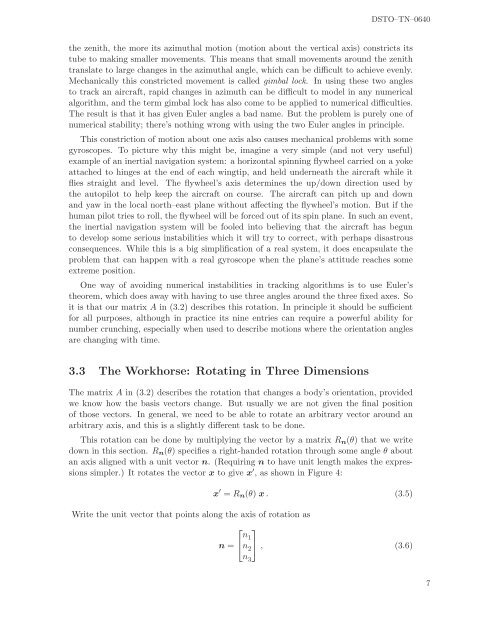Using Rotations to Build Aerospace Coordinate Systems - Defence ...
Using Rotations to Build Aerospace Coordinate Systems - Defence ...
Using Rotations to Build Aerospace Coordinate Systems - Defence ...
Create successful ePaper yourself
Turn your PDF publications into a flip-book with our unique Google optimized e-Paper software.
DSTO–TN–0640the zenith, the more its azimuthal motion (motion about the vertical axis) constricts itstube <strong>to</strong> making smaller movements. This means that small movements around the zenithtranslate <strong>to</strong> large changes in the azimuthal angle, which can be difficult <strong>to</strong> achieve evenly.Mechanically this constricted movement is called gimbal lock. In using these two angles<strong>to</strong> track an aircraft, rapid changes in azimuth can be difficult <strong>to</strong> model in any numericalalgorithm, and the term gimbal lock has also come <strong>to</strong> be applied <strong>to</strong> numerical difficulties.The result is that it has given Euler angles a bad name. But the problem is purely one ofnumerical stability; there’s nothing wrong with using the two Euler angles in principle.This constriction of motion about one axis also causes mechanical problems with somegyroscopes. To picture why this might be, imagine a very simple (and not very useful)example of an inertial navigation system: a horizontal spinning flywheel carried on a yokeattached <strong>to</strong> hinges at the end of each wingtip, and held underneath the aircraft while itflies straight and level. The flywheel’s axis determines the up/down direction used bythe au<strong>to</strong>pilot <strong>to</strong> help keep the aircraft on course. The aircraft can pitch up and downand yaw in the local north–east plane without affecting the flywheel’s motion. But if thehuman pilot tries <strong>to</strong> roll, the flywheel will be forced out of its spin plane. In such an event,the inertial navigation system will be fooled in<strong>to</strong> believing that the aircraft has begun<strong>to</strong> develop some serious instabilities which it will try <strong>to</strong> correct, with perhaps disastrousconsequences. While this is a big simplification of a real system, it does encapsulate theproblem that can happen with a real gyroscope when the plane’s attitude reaches someextreme position.One way of avoiding numerical instabilities in tracking algorithms is <strong>to</strong> use Euler’stheorem, which does away with having <strong>to</strong> use three angles around the three fixed axes. Soit is that our matrix A in (3.2) describes this rotation. In principle it should be sufficientfor all purposes, although in practice its nine entries can require a powerful ability fornumber crunching, especially when used <strong>to</strong> describe motions where the orientation anglesare changing with time.3.3 The Workhorse: Rotating in Three DimensionsThe matrix A in (3.2) describes the rotation that changes a body’s orientation, providedwe know how the basis vec<strong>to</strong>rs change. But usually we are not given the final positionof those vec<strong>to</strong>rs. In general, we need <strong>to</strong> be able <strong>to</strong> rotate an arbitrary vec<strong>to</strong>r around anarbitrary axis, and this is a slightly different task <strong>to</strong> be done.This rotation can be done by multiplying the vec<strong>to</strong>r by a matrix R n (θ) that we writedown in this section. R n (θ) specifies a right-handed rotation through some angle θ aboutan axis aligned with a unit vec<strong>to</strong>r n. (Requiring n <strong>to</strong> have unit length makes the expressionssimpler.) It rotates the vec<strong>to</strong>r x <strong>to</strong> give x ′ , as shown in Figure 4:Write the unit vec<strong>to</strong>r that points along the axis of rotation asx ′ = R n (θ) x. (3.5)⎡ ⎤n 1n = ⎣n 2⎦ , (3.6)n 37
















